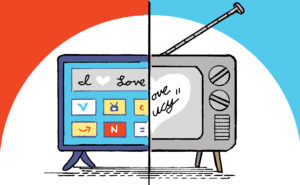It sure feels like Nielsen has had a rough go of it lately. (Again.)
At the beginning of 2025, the TV measurement provider seemed poised to enter this year’s upfronts with the right foot forward. In January, it achieved Media Rating Council (MRC) accreditation for its Big Data + Panel offering, which CEO Karthik Rao promised would provide “the most accurate measurement in the history of TV” in a press statement at the time.
Not soon after, Nielsen also told ad buyers that it would be dropping its panel-only ratings and completely endorsing Big Data + Panel as its preferred currency for upfronts, a change that many advertisers were initially excited about. It even welcomed Paramount back into the fold in February after over four months of contract negotiations, signaling that, finally, things might be back on track.
But now that upfront negotiations are almost over, the industry appears to have settled back into its default position of being mad at Nielsen – which is likely good news for its currency competitors, but not so great for everyone else in the meantime, including Nielsen, of course.
What happened?
Let’s rewind.
The big gossip at Cannes this year revolved around a meeting that had taken place just before the festival on June 12 between the Video Advertising Bureau (VAB) and Nielsen, along with nine heads of ad sales and six heads of research from various publishers and agency holdcos.
The meeting was called out of “abject frustration,” VAB CEO and President Sean Cunningham told AdExchanger. Industry leaders were beyond fed up with discrepancies they’d been seeing in Nielsen’s Big Dig Panel + Data product – including a steep month-over-month drop in adults aged 25 to 54 and some sudden under- or over-indexing of demographics that don’t make sense in context. (It would be unusual if a show with adult themes suddenly started ranking higher with kids under 18, as a hypothetical example.)
Some of the heads of research suspected that Nielsen’s Household Demographic Assessment Model (HDAM) was to blame for these inconsistencies and had told Nielsen so sometime in June 2024, according to Cunningham.
The HDAM is a machine-learning algorithm that estimates demographic information for data sets lacking these details, such as set-top box data. Nielsen first included set-top box data to its TV ratings currency in late 2020, using HDAM to assign demographics and improve the accuracy of its audience measurement.
In response to these concerns, Nielsen agreed to look into making changes to its HDAM model. Cunningham also said that Nielsen “promised a month’s worth of impact data in mid-July.”
But in an email to clients sent on July 10, Nielsen concluded that HDAM was “not driving significance in demographics between panel-only and Big Panel + Data services,” and that making “piecemeal enhancements” to the HDAM would actually prove more disruptive than beneficial this late into the buying cycle.
Nielsen also said it would not be making HDAM evaluation data available in NPOWER, which is the company’s audience insights platform.
What’s the problem?
More so than any other advertising channel, TV ad buying is a futures market, meaning that publishers and advertisers alike need accurate data to predict where they’re most likely to reach their target audiences in the upcoming television season.
Some big programmers – particularly those that distribute massive sporting events – have large enough portfolios that they can overcome the challenges posed by inconsistent ratings data, said VideoAmp EVP Aaron Lilly.
But midsized and long-tail networks are already struggling to measure their increasingly fragmented audiences. As viewers spend time across more channels, the panels to measure their behavior necessarily become smaller and less representative, making it difficult to reliably extrapolate insights.
If smaller TV programmers can’t demonstrate evidence of their audience size and composition, advertisers will be less likely to buy with them.
Similarly, new shows don’t have viewership data (because they haven’t actually aired yet) and are instead typically sold against existing benchmarks for popular airtimes or similar programs. If that data isn’t consistent, either, then buyers may not be willing to risk spending ad dollars on what is, essentially, an unknown quantity.
What’s next?
That said, Nielsen is still a behemoth. Seven of the largest agencies, including six holdcos, all recently renewed long-term, multiyear partnership deals with Nielsen’s Big Data + Panel product.
“We’re proud to be the first company to earn accreditation for Big Data + Panel and first-party live streaming, while continuing to expand out-of-home measurement,” a Nielsen spokesperson told AdExchanger in an emailed statement. “And that only covers the past few months of enhancements for our clients.”
But given Nielsen’s recent history – losing its national and local TV MRC accreditation in 2021, then gaining it back for national TV in 2023 – being perceived as having volatile or unstable panel data could only further undermine the company’s current market dominance.
Meanwhile, ongoing uncertainty around the accuracy of Nielsen’s measurement will likely reignite interest in multicurrency approaches, which picked up steam during the roughly year and a half that Nielsen was without accreditation, but felt relatively dormant during the 2025 upfronts presentations.
To be fair, most of Nielsen’s major competitors are no longer small, scrappy startups.
Both iSpot and Comscore achieved their own national TV accreditation in 2023 and 2024, respectively (including local TV for Comscore, which Nielsen has not yet earned back). VideoAmp formally initiated its own MRC audit process in May.
Comscore, iSpot and VideoAmp have all three also been certified by the Joint Industry Committee (JIC), which, unlike the MRC, concentrates on the way buyers and sellers actually transact on various currencies. (So far, Nielsen has not participated in the JIC certification process.)
And Nielsen’s competitors spot an opportunity if programmers’ trust in Nielsen numbers stays shaken. VideoAmp’s Lilly, for one, smells blood in the water. He feels confident that the next 12 months will provide a “massive opportunity” for the alternative currency company.
“I’ve never been more bullish in my three and a half years here,” said Lilly.















